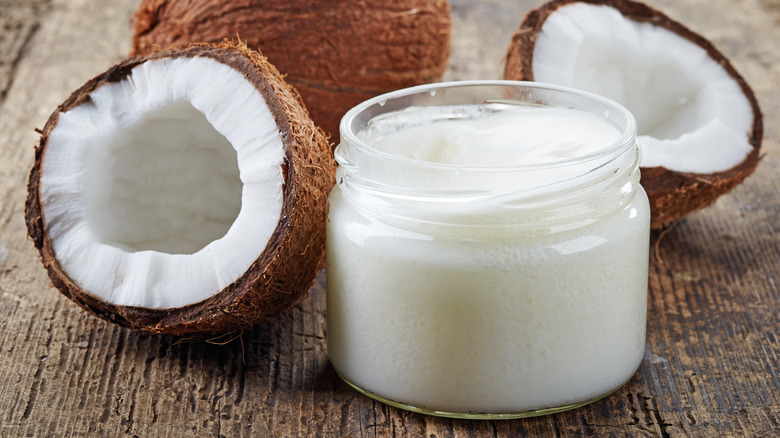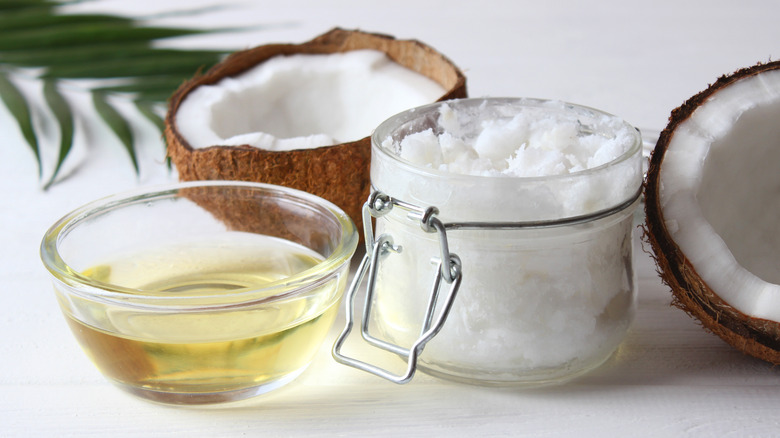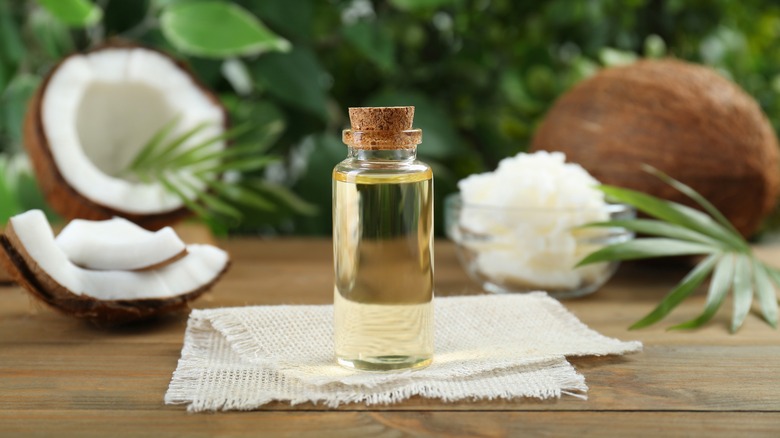The Best Way To Store Coconut Oil For The Longest Shelf Life
Many parts of the world have a favorite local cooking fat. Many Americans love soybean oil and you can easily find food made with it across the U.S, while olive oil is the heart and soul of Mediterranean cooking. But if you ever get the chance to visit Southeast Asia, lots of the foods you can eat here (especially traditional dishes) are cooked with coconut oil. Pressed from fresh coconut meat, which contains as much as 40% oil while fresh, coconut oil has been a culinary staple here for over 4,000 years and is prized for its distinctive nutty flavor.
Another highlight of coconut oil is its long shelf life. When stored properly, coconut oil can easily last for up to two years. The keyword here is properly — if you're given a fresh jar or bottle of coconut oil, you'll need to have the correct storage technique. Else, you'll find the oil's quality is slipping in just a few months. You see, coconut oil is highly sensitive to its environment and can quickly turn rancid when it's exposed to high humidity, heat, intense light (like direct sunlight), or prolonged air contact. In extreme cases, you might even have mold growing in the jar.
But don't let that scare you off! Keeping your coconut oil fresh is actually quite simple. All you need is a good container and a cool, dark storage spot.
Environment-proofing is the key
There are two kinds of coconut oil you can buy: Refined and unrefined. Unrefined, or virgin coconut oil is the one that tastes the most "coconut-y" and is basically fresh oil pressed from coconut meat. The refined version is filtered to take out impurities and is used as a neutral cooking fat since most of its flavor is also scrubbed. Both have similar storage processes, but their shelf-life will differ — refined coconut oil lasts extremely long (up to five years) while around two years is the norm for unrefined.
If your coconut oil bottle is clear, the first order of business is to light-proof it. Transfer it to an opaque or dark-colored container to prevent the oil from oxidizing in the light, but avoid using a metal container as it can taint the oil's flavor. Snap the lid on as tightly as you can and make sure that it's airtight — air exposure can ruin the oil. This is why, if you don't use coconut oil frequently, consider dividing the oil into smaller portions. You'll be able to gradually use up your supply without exposing everything to air each time you open the jar.
Then, find a cool, dark, and dry spot in the house. A pantry is perfect, but a kitchen drawer or cabinet works too. Just keep it far away from the stove and the open windows — any kind of heat or light is bad news for your coconut oil.
Is it bad if my coconut oil melts?
Coconut oil, unlike most types of cooking fats, is a white, waxy solid at room temperature (around 75 degrees Fahrenheit.) If you live somewhere that's hotter than this, by the time you open up the jar to check in on the oil (which you should do once every couple of months to make sure it's doing alright in storage,) it might've melted down into a liquid. No worries, this is perfectly normal and doesn't affect the oil's quality. In fact, many people prefer using coconut oil while it's in its liquid form, as it's easier to pour into a pan.
If you prefer your coconut oil to be solid, simply refrigerate it for about an hour. You can keep it in the fridge full-time if you so choose, but the oil will turn into a block of fat that can be difficult to scoop and use. A quick fix for this is to let it soften by letting it "thaw" on the countertop for a few minutes before you use it.
For the best of both worlds, consider dividing your coconut oil into two portions. Keep one jar in the fridge for recipes that use solid coconut oil, like as a butter substitute for homemade cookies or for the crispiest grilled cheese. Store the other at room temperature for easy pouring in recipes like gluten-free coconut and pecan granola. This way, you'll always have the right form of coconut oil ready to go!


